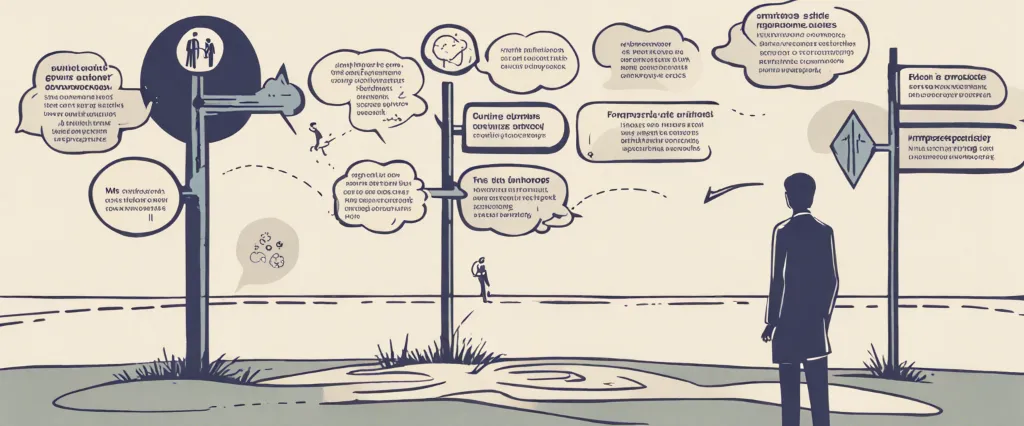In “The Most Important Thing”, renowned investor Howard Marks offers readers an enlightening perspective on the complex and often ambiguous nature of investing. Drawing from his vast experience and deep understanding of market dynamics, Marks shares his wisdom on navigating the financial world to achieve long-term success. As the Co-Chairman and Co-Founder of Oaktree Capital Management, one of the largest global investment firms, Marks has earned a stellar reputation for his insightful and contrarian approach. With a focus on risk management and the importance of second-level thinking, Marks presents a compelling argument for approaching investments with caution, discipline, and a deep understanding of market cycles.
Chapter 1: The Most Important Thing Is… Second-Level Thinking
Chapter 1 of “The Most Important Thing” by Howard Marks, titled “The Most Important Thing Is… Second-Level Thinking,” explores the concept of second-level thinking and its significance for successful investing. Marks emphasizes that to be a successful investor, one must engage in non-conventional, deeper, and more nuanced thinking than the average market participant.
Second-level thinking involves considering not only the obvious impacts of a decision but also the potential consequences that result from it. To make informed investment choices, one should move beyond merely predicting what will happen in the future and instead focus on understanding how the market will react to various scenarios.
Marks highlights that investors often struggle to think beyond first-level thinking due to psychological biases, reliance on common practices, and the desire for simplification. This limitation leads to herd behavior and market inefficiencies that can create opportunities for those who engage in second-level thinking.
The author also discusses the importance of understanding market cycles and the risk of following the herd. He urges investors to be contrarian and not to let emotions dictate their decisions. Marks emphasizes the need for caution during positive market conditions and the potential rewards during negative market conditions when prices are low and sentiment is pessimistic.
In summary, chapter 1 introduces the concept of second-level thinking as a crucial component of successful investing. Through this more detailed and multidimensional thought process, investors can uncover hidden opportunities and avoid costly mistakes. Marks emphasizes the importance of contrarian thinking, not following the crowd, and understanding market cycles to achieve superior investment results.
Chapter 2: The Most Important Thing Is… Understanding Risk
Chapter 2 of “The Most Important Thing” by Howard Marks is titled “Understanding Risk.” In this chapter, Marks emphasizes the significance of comprehending and managing risk when it comes to investing. He believes that risk is the most crucial element to consider in investing and that a deep understanding of risk is paramount for successful investing.
Marks identifies two kinds of risks: risk of loss and risk of missed opportunity. He emphasizes that investors must focus more on controlling risk of loss rather than chasing high returns. Avoiding big losses is more important as they can have a severe impact on investment portfolios and can be hard to recover from.
The chapter delves into the various sources of risk, including economic, market, interest rate, and credit risks. Marks stresses the importance of recognizing risk and assessing its potential impact on investments. He advises investors to carefully analyze the factors that contribute to risk and to be cautious when investing in uncertain environments.
Moreover, Marks introduces the concept of second-level thinking, which he considers crucial for understanding risk. Second-level thinking involves going beyond the obvious and considering the potential consequences of an investment decision. It requires analyzing not only what the market thinks, but also how the market might be wrong.
In summary, Chapter 2 of “The Most Important Thing” emphasizes the importance of understanding and managing risk in investing. Marks highlights that risk of loss should be a priority over chasing high returns. He discusses various sources of risk and encourages investors to adopt second-level thinking to gain a deeper understanding of risk and make informed investment decisions.
Chapter 3: The Most Important Thing Is… Recognizing Market Cycles
Chapter 3 of Howard Marks’ book, “The Most Important Thing,” titled “Recognizing Market Cycles,” delves into the crucial concept of market cycles and their impact on investments. Marks emphasizes the importance of recognizing where we stand in the market cycle as a key determinant of investment success.
Marks highlights that markets are cyclical, fluctuating between periods of optimism and pessimism. He explains that understanding these cycles and their dynamics can help investors make better decisions. The timing of investments greatly affects returns, and failing to recognize market cycles can lead to costly mistakes.
Marks introduces the concept of pendulum swings, stating that market sentiment oscillates between extremes of fear and greed. He advises investors to be cautious during periods of excessive optimism, as this often leads to overvaluation and speculation. Conversely, during periods of excessive pessimism, assets may be undervalued, presenting attractive investment opportunities.
The author stresses the difficulty of accurately predicting cycles, acknowledging that it can be challenging to identify when exactly a cycle will peak or hit bottom. However, he emphasizes the importance of recognizing where we generally stand within the cycle and adjusting investment strategies accordingly.
Marks cautions against overly relying on macroeconomic trends, as they often fail to provide definitive timing signals for market movements. Instead, he advises investors to focus on fundamental analysis and market psychology, paying attention to valuations, investor behavior, and contrarian indicators.
In conclusion, Chapter 3 of “The Most Important Thing” highlights the significance of recognizing market cycles for successful investing. Howard Marks urges readers to remain aware of the pendulum swings of market sentiment, acknowledging that while predicting exact turning points is challenging, understanding the broader cycle can guide investment decisions effectively. Awareness of market psychology and fundamentals is critical in navigating market cycles and positioning investments wisely.
Chapter 4: The Most Important Thing Is… Knowing What You Don’t Know

Chapter 4 of Howard Marks’ book “The Most Important Thing” is titled “The Most Important Thing Is… Knowing What You Don’t Know.” Marks explores the concept of humility and self-awareness as essential traits for successful investors.
Marks begins by highlighting the inherent uncertainty and complexity of the financial markets. He stresses the importance of recognizing that no one has all the answers or can predict the future with absolute certainty. The increasing specialization and rapid changes within the investment industry make it impossible to possess complete knowledge of every aspect.
The chapter delves into the various sources of ignorance that can hinder investors. Marks emphasizes that acknowledging and accepting what we don’t know is crucial in managing risk and making wise investment decisions. Additionally, he warns against the dangers of overconfidence and the belief that one possesses superior knowledge or insight.
Marks provides several examples and anecdotes to emphasize his points. He emphasizes the importance of having a margin of safety, identifying potential pitfalls, and conducting thoughtful analysis. Recognizing the limits of our knowledge enables us to be more cautious, conservative, and to consider alternatives.
In essence, Marks argues that humility and self-awareness are the keys to successful investing. By acknowledging one’s limitations and being open to learning from mistakes and others’ perspectives, investors can navigate the uncertain territory of the financial markets with greater prudence.
By the end of the chapter, readers are left with the crucial message that understanding what we don’t know is as essential as understanding what we do know, allowing investors to make more informed choices and better manage the inherent risk of investing.
Chapter 5: The Most Important Thing Is… Controlling Emotions
Chapter 5 of “The Most Important Thing” by Howard Marks is titled “Controlling Emotions,” and it delves into the significant role emotions play in successful investing. Marks highlights the importance of emotional control for investors to make rational decisions and avoid common pitfalls.
The author begins the chapter by acknowledging that emotions often lead investors to make poor choices. Fear and greed are dominant emotions that can cloud judgment and push investors into making unwise decisions. Marks emphasizes the need to remain calm and objective, especially during market booms and busts when emotions are heightened.
Furthermore, Marks discusses the concept of second-level thinking, which involves recognizing that success in investing requires thinking differently from the crowd. Emotionally driven investors tend to follow popular trends, often driven by greed, rather than conducting in-depth analysis and exercising skepticism. Second-level thinkers, on the other hand, strive to think independently, question assumptions, and consider all possible scenarios.
Marks also discusses various psychological biases, such as overconfidence, overreaction to recent events, and anchoring, which can influence decision-making. He emphasizes the importance of identifying and managing these biases to avoid making irrational choices.
Overall, Chapter 5 “Controlling Emotions” stresses that successful investing requires emotional control, independent thinking, and self-awareness. Marks advises investors to develop discipline, avoid impulsive actions, and base decisions on thoughtful analysis rather than emotional reactions. By understanding and managing their own emotions, investors can improve their chances of making rational and prudent investment decisions.
Chapter 6: The Most Important Thing Is… Having a Sense of Where We Stand
Chapter 6 of “The Most Important Thing” by Howard Marks is titled “The Most Important Thing Is… Having a Sense of Where We Stand.” In this chapter, Marks emphasizes the significance of understanding one’s current position in the market or investment landscape.
Marks highlights that assessing the current environment is crucial in determining the appropriate investment strategy. He acknowledges that market cycles are inevitable, and investors must recognize whether they are in times of optimism or pessimism. Marks advises against excessive optimism because it tends to lead to overpriced investments, while excessive pessimism can result in undervalued opportunities being overlooked.
To develop a sense of where we stand, Marks argues that investors need to be aware of the prevailing market conditions and must be willing to adapt their strategies accordingly. He introduces the concept of “second-level thinking,” which refers to considering not just what the market knows but also what the market might be missing. This deeper level of thinking requires investors to analyze different scenarios and potential outcomes to gain an edge in decision-making.
Moreover, Marks emphasizes the importance of understanding one’s own limitations. He suggests that investors should be aware of their areas of expertise and stay within their circle of competence. Investors who venture outside of their comfort zone are more likely to make mistakes and be exposed to risks they may not fully understand.
Ultimately, having a sense of where we stand allows investors to navigate the market with better judgment and make more informed investment decisions. By continuously assessing market conditions and recognizing one’s own limitations, investors can position themselves to take advantage of opportunities and manage risk effectively.
Chapter 7: The Most Important Thing Is… Appreciating the Role of Luck
Chapter 7 of “The Most Important Thing” by Howard Marks is titled “Appreciating the Role of Luck.” In this chapter, Marks emphasizes the significance of luck in investment success and encourages investors to understand and appreciate its role.
Marks begins by differentiating between two types of luck: random or good/bad luck, and skilled or smart/good luck. Random luck refers to unpredictable events or circumstances that can significantly affect investment outcomes but are beyond an investor’s control. Skilled luck, on the other hand, is the result of an investor’s skill, analysis, and decision-making abilities.
The author highlights that many successful investors attribute a large part of their success to luck. Often, investors overlook or underestimate the role luck plays in their achievements and attribute their success solely to their skill and intelligence. Marks believes that it is crucial for investors to acknowledge and appreciate the role of luck to maintain a realistic and humble perspective on their investment outcomes.
Moreover, the author discusses how acknowledging the role of luck helps investors avoid becoming overconfident and making irrational decisions. He emphasizes the importance of humility and caution, especially during periods of success or when markets are performing favorably.
Marks advises investors to focus on process and sound decision-making instead of solely on outcome. A good process, combined with skill, increases the probability of favorable outcomes, but luck remains an important factor. By acknowledging luck’s role, investors can better assess risks, remain disciplined, and avoid taking undue credit for successes or blaming themselves for failures.
In summary, Chapter 7 underscores the significance of luck in investment success. It stresses the importance of recognizing and appreciating luck’s role to maintain a realistic perspective and make informed investment decisions. By understanding the interplay of luck and skill, investors can navigate the complex world of investing more effectively.

Chapter 8: The Most Important Thing Is… Being Mindful of the Big Picture
Chapter 8 of “The Most Important Thing” by Howard Marks is titled “The Most Important Thing Is… Being Mindful of the Big Picture.” In this chapter, Marks emphasizes the significance of considering the overall market environment while making investment decisions.
Marks begins by highlighting the cyclicality of markets and the tendency for investors to get caught up in short-term fluctuations. He advises against becoming overly focused on short-term gains or losses and encourages readers to adopt a long-term perspective. According to him, investors who are mindful of the big picture are more likely to succeed in the long run.
The author stresses the importance of understanding the market cycle and recognizing various stages, such as booms and busts. Marks explains how different market conditions affect asset prices and investor behavior. By grasping these patterns, investors can better navigate through different market cycles and adjust their strategies accordingly.
Furthermore, Marks reminds readers about the significance of risk management. He emphasizes that risk cannot be eliminated entirely, but it can be managed. Investors should be aware of the risk inherent in their portfolios and focus on preserving capital during more challenging market conditions.
Marks concludes the chapter by reiterating that successful investing is not just about individual stock selection but about being aware of the broader market landscape. Striving for a well-informed, long-term perspective and being mindful of the big picture increases the chances of investment success over time.
In summary, Chapter 8 of “The Most Important Thing” emphasizes the importance of looking at the big picture when making investment decisions. Understanding market cycles, managing risk, and adopting a long-term perspective are key principles highlighted in this chapter. By considering the broader market environment, investors can better navigate through different phases of the market cycle and increase their chances of long-term success.
After Reading
In conclusion, “The Most Important Thing” by Howard Marks is an insightful and thought-provoking book that explores the key principles and concepts of successful investing. Through various real-life examples and personal experiences, Marks emphasizes the importance of understanding risk, finding an optimal balance between fear and greed, and developing a contrarian mindset. By focusing on the fundamental aspects of investing rather than relying on short-term market trends, Marks encourages readers to adopt a long-term and disciplined approach to achieve better investment results. Overall, “The Most Important Thing” offers valuable insights and lessons that can benefit both experienced investors and novices in navigating the complex world of finance.
1. “Margin of Safety: Risk-Averse Value Investing Strategies for the Thoughtful Investor” by Seth A. Klarman – This book offers insightful advice on value investing and the importance of a margin of safety, similar to the key principles discussed in “The Most Important Thing.”
2. The Intelligent Investor: The Definitive Book on Value Investing” by Benjamin Graham – Regarded as a classic in the field of investing, this book delves into various investment strategies, risk management, and the importance of patience and discipline, much like the teachings in “The Most Important Thing.
3. Thinking, Fast and Slow” by Daniel Kahneman – In this book, Nobel laureate Daniel Kahneman explores the two systems of thought that drive our decision-making process. Like “The Most Important Thing,” it emphasizes the significance of recognizing and managing biases and emotions when making investment decisions.
4. A Random Walk Down Wall Street: The Time-Tested Strategy for Successful Investing” by Burton G. Malkiel – This book discusses the efficient market hypothesis and advocates for adopting a passive investment strategy through index funds. It relates to the principles of long-term thinking and diversification outlined in “The Most Important Thing.”
5. The Little Book of Common Sense Investing: The Only Way to Guarantee Your Fair Share of Stock Market Returns” by John C. Bogle – Written by the founder of Vanguard Group, this book highlights the importance of low-cost, broad-based index funds as the optimal choice for individual investors. It aligns with the emphasis on simplicity and the avoidance of unnecessary investment costs mentioned in “The Most Important Thing.”



